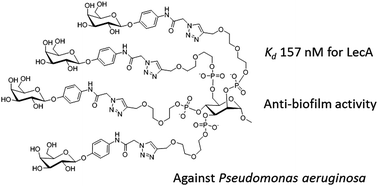Mannose-centered aromatic galactoclusters inhibit the biofilm formation of Pseudomonas aeruginosa†
Abstract
Pseudomonas aeruginosa (PA) is a major public health care issue due to its ability to develop antibiotic resistance mainly through adhesion and biofilm formation. Therefore, targeting the bacterial molecular arsenal involved in its adhesion and the formation of its biofilm appears as a promising tool against this pathogen. The galactose-binding LecA (or PA-IL) has been described as one of the PA virulence factors involved in these processes. Herein, the affinity of three tetravalent mannose-centered galactoclusters toward LecA was evaluated with five different bioanalytical methods: HIA, ELLA, SPR, ITC and DNA-based glycoarray. Inhibitory potential towards biofilms was then assessed for the two glycoclusters with highest affinity towards LecA (Kd values of 157 and 194 nM from ITC measurements). An inhibition of biofilm formation of 40% was found for these galactoclusters at 10 μM concentration. Applications of these macromolecules in anti-bacterial therapy are therefore possible through an anti-adhesive strategy.

- This article is part of the themed collection: Multivalent Biomolecular Recognition

 Please wait while we load your content...
Please wait while we load your content...